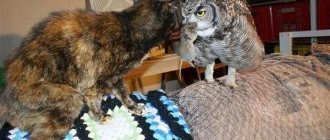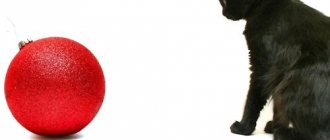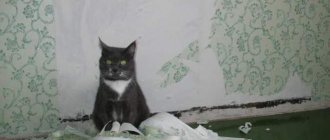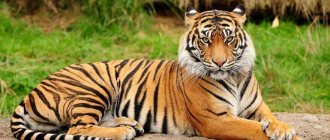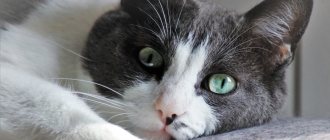The cat's nose is normal
What we are accustomed to calling the nose is called the nasal planum among representatives of the cat family. A unique pattern stands out on the surface, like on people’s fingertips. This pattern is unique, like fingerprints or an iris pattern. Perhaps in the future nose prints will appear as an identifier in cat documents.
A healthy, awake cat's nose is slightly moist, cold, without defects in the skin and mucous membranes . The nasal passages are clean, breathing is free. If it is hot, this is a reason to take a closer look at the animal.
When to sound the alarm
A hot, dry nose, a cracked earlobe, and nasal discharge of various types most often indicate the development of viral infections and parasitic diseases, which are accompanied by inflammatory processes.
Alarming symptoms:
- change in behavior (lethargy, drowsiness, uncooperative cat);
- inadequate response to stimuli;
- ocular, nasal discharge;
- crusts, wounds on the face, nose;
- refusal to eat;
- digestive disorders;
- wheezing, wheezing when breathing;
- fever, chills;
- coughing, sneezing, asthma attacks, difficulty breathing;
- poor quality wool, the appearance of bald patches, skin rashes.
Important! If a cat's dry nose is caused by high temperature, the pads on its paws will also be hot. At the same time, high temperature is always one of the symptoms of the development of diseases and systemic pathologies, so show the cat to a veterinarian.
Dry nose in a cat can be caused by allergies, dermatological diseases, problems in the gastrointestinal tract, chronic pathologies, respiratory diseases, fever, autoimmune diseases, and the presence of foreign bodies in the nose. Possible causes of a hot nose are dehydration (dehydration), poisoning, and intoxication of the body.
What does a dry nose mean in a cat?
A cat's dry and hot nose can mean several things:
- about illness;
- on the use of medicines;
- that the cat woke up recently.
To maintain your pet's health, you need to be able to distinguish when your furry pet needs help and when it is healthy.
Signs of illness
A dry nose is far from the main symptom of the disease. However, there are many conditions where a dry, hot nose is an additional symptom. Watch the cat.
- Assess how active your pet is. There are lazy cats that refuse to play even in perfect health. A thrifty owner can easily guess whether it’s time for his mustachioed roommate to go to the clinic.
- Take a closer look at the bowls. Does the cat eat the usual amount of food, does it eat too much, does it willingly approach the bowl before feeding, does it drink more than usual.
- How often does he use the tray and what is the output?
- Is there any vomiting or diarrhea?
- Does he sit on the tray too often, or does he make unsuccessful attempts to urinate?
- The pet's coat should be smooth, shiny and clean, especially near natural openings: nose, ears, eyes and crotch area.
- There should be no mucous or, especially, purulent discharge from the eyes and nose. Sneezing and especially coughing are a reason to visit a doctor.
In some diseases, the skin of the nasal planum is affected: foci of inflammation and ulcers appear. In the vast majority of cases, this indicates a viral disease - calicivirus. You can protect your pet with regular preventive vaccinations.
Pathologies after castration and sterilization
To perform an operation, anesthesia and preparation drugs are required. Among medications, those that reduce the secretion of glands play an important role. This is necessary so that mucus does not accumulate in the bronchi of patients.
Unfortunately, the drug affects all glands, including those that moisturize the nasal planum. Some drugs directly for anesthesia have a similar property.
It is because of the action of such drugs that the nose of cats after castration or sterilization becomes dry and hot within 24 hours. This is fine.
You don’t need to talk to the surgeon about a dry nose, but the owner’s assessment of the pet’s activity, the presence of natural bowel movements, the amount of water drunk and, not before the doctor’s permission, appetite is extremely important information. It must be provided to the veterinarian at a follow-up appointment.
When there is no reason to worry
In perfectly healthy cats that are deeply asleep, the nose becomes hot. The dry state persists even after waking up. If everything else is fine with your pet, then there is no need to worry.
A dry and hot nose without additional symptoms is not a reason to go to the clinic.
The nose can be hot and dry in healthy cats when the humidity in the apartment is too low. In such cases, people use moisturizer, but animals have to endure dryness.
An air humidifier will help a lot – not only for the cat, but also for the owners. It is better to choose analog: ultrasonic irritates some mammals.
Kitten's nose
In kittens, just like in adult animals, the nose should be clean, slightly damp, cool, but not dry. Babies can have a hot, warm, dry earlobe during sleep, immediately after waking up, during prolonged active play, or during severe stress. This is the norm.
© shutterstock
If the nose remains dry and hot for a long time, covered with crusts, we recommend that you seek help from a veterinarian. A lobe that is hot to the touch signals the development of an infection, an inflammatory process, and indicates a general deterioration in health.
Treatment and prevention
A dry and hot nose for a long period of time usually indicates an elevated temperature due to the development of various diseases. If this symptom is accompanied by other signs of pathology, owners should not self-medicate.
The cat needs to be shown to a doctor as soon as possible, who will conduct the necessary studies, make a diagnosis, and also select the necessary treatment.
Measuring the temperature is the only thing the owner needs to do if the animal has a warm and dry nose. If it rises to 39–40°C, it is forbidden to give the cat medications, especially antipyretic drugs that are intended for humans.
Before being examined by a doctor, your pet’s condition can also be alleviated in the following ways:
- applying ice;
- fresh air flow into the room;
- plenty of cool drinks.
High body and nasal temperature can usually indicate the development of the following diseases in an animal:
- Urolithiasis and other kidney pathologies. A cat with urolithiasis and other kidney disorders should only be prescribed medications by a doctor. Typically, therapeutic therapy for this disease includes not only diet, but also the administration of antispasmodics, painkillers and anti-inflammatory drugs. In the most severe cases, cats undergo bladder catheterization.
- Accumulation of wool in the stomach and intestines. To remove hairballs, you need to give your pet special food. You can also offer your cat sprouted grass, which promotes the successful removal of fur from the gastrointestinal tract.
- Poisoning and other digestive disorders. Treatment for gastrointestinal diseases depends on the type of pathology identified in the pet. Typically, cats are prescribed antibiotics and probiotics, as well as solutions to prevent dehydration, antiemetics, antidiarrheals and pain relievers.
- Allergy. Treatment begins with identifying the cause of the disease. Next, you need to eliminate the allergen that caused this reaction and take a course of antihistamines.
- Colds. Treatment of various colds in cats is usually aimed at relieving the symptoms of the disease. As a rule, it includes taking antibiotics and vitamins, using antiseptic solutions and nasal drops.
- Viral diseases (rhinotracheitis, calcivirosis). To treat viral diseases, the veterinarian will prescribe antiviral and immunomodulatory drugs, antibiotics and other medications that eliminate the symptoms of the disease. The cat will also need to take vitamin supplements.
There are no special methods for preventing the physiological causes of dry and warm noses in cats. To avoid dryness and increased temperature of the nasal “mirror” due to the development of any pathology, owners need to follow certain rules:
- Avoid contact of your pet with sick animals.
- Treat emerging diseases in a timely manner to prevent their transition to the chronic stage.
- Take your cat regularly for preventive vaccinations and examinations.
- Make your pet's diet as balanced as possible.
A cat's dry and warm nose does not always indicate that it is sick. Sometimes, if the animal has no signs of illness, it will be enough to simply wait until the nasal “mirror” becomes moist and cool on its own. However, if your cat develops other symptoms of any pathology, you should not self-medicate, but rather immediately show the animal to a doctor.
What kind of nose should a kitten have?
The answer to the question of what kind of nose a healthy kitten should have is short and obvious - like that of an adult. A baby's nose should normally be smooth, slightly moist and cool.
You just need to know that kittens have a normal body temperature of 39.6°C (hairless babies have 40-41°C). Therefore, their small noses are always warmer than those of adult predators. There is no need to worry if your kitten has a dry nose all day long. The cub is healthy if it is playful, active, has a good appetite and sleeps soundly.
Causes of dry nose
First of all, you shouldn't worry about this right away. There are many more reasons why a cat has a dry nose than you might imagine, and not all of them are hazardous to health or simply problematic.
First, let's talk about the simplest and most ordinary situations that can occur every day, or even several times a day.
We are now talking about the simple time after sleep. The fact is that after sleep, cats' noses will always be a little dry and this is quite normal. In this case, the reasons for a cat’s dry nose lie in the fact that during sleep he simply does not lick it, which is why this happens.
The same story will happen with excessive activity, especially if it all happened in the fresh air and under the sun.Read here Otodectosis in cats: first symptoms, diagnosis of the disease and treatment options (110 photos)
In this case, both the environment and the cat’s own body temperature play an important role, which becomes noticeably higher during physical activity. We are not yet talking about additional factors, such as dust, strong wind, and so on.
The most interesting thing is that similar things can happen under normal conditions at home, especially in winter, when the cat lies for a long time near or even on the heating radiator.
It is not uncommon for cats to have a dry nose at fairly low temperatures. This happens because a cat instinctively stops licking its nose when the environment becomes too cold.
In this case, you should not think about whether the cat should have a dry or wet nose - it is better to wait until he gets into a more normal environment for an extended period of time.
Cat fingerprinting
You've probably noticed that cats' noses are rough. But every cat has its own unique pattern on its nose. This uniqueness is akin to human fingerprints. Just as you can't find two people with the same prints, you can't find two cats with the same nose pattern. This feature can be used to recognize animals.
The color of the nose depends on the color of the cat as a whole. Some cat breeds are distinguished by the fact that their noses have a dark edging. For example, the chinchilla breed can boast of such natural “eyeliner”.
Examination of the cat's nasal cavity
A specialist must examine the nasal cavity, using a special device equipped with lighting and a video camera - an endoscope.
The procedure is usually done under anesthesia, as it is not pleasant and sometimes painful for the animal.
To make a diagnosis, in addition to endoscopy, sputum examinations and blood tests are used. What research needs to be done is determined by the doctor based on the collected medical history and symptoms of the disease accompanying rhinitis.
Diseases of cats and cats: symptoms and treatment
According to many people, cats are one of the most tenacious creatures. Is this really how it is?
Indeed, it is difficult to classify cats as sick creatures. They are less susceptible to various diseases than other animals. But like any animal, cats can get sick with specific feline diseases or catch a cold, and they can become obese.
It is worth mentioning that domestic (pedigreed) cats are more susceptible to diseases than barn cats. Long-haired cats get sick more often than short-haired cats.
Determining the symptoms of the disease in cats is quite problematic.
When cats become ill, they behave like steadfast tin soldiers, often hiding their illness.
Cats can have similar symptoms for different diseases. Therefore, to establish the cause of the disease and correct diagnosis, the cat should be immediately shown to a veterinarian. By the appearance and habits of the animal, you can determine the true state of health of your pet.
If a cat is active, eats well, and has a shiny, well-groomed coat, then it is completely healthy.
If the owner sees that the cat is lethargic, sleeps a lot, eats poorly and has unkempt fur, then this is a clear sign that not everything is in order with your pet’s health.
In this case, you should not hesitate to contact a veterinarian; delay may negatively affect the animal’s well-being.
Commonly known symptoms
One of the clearest criteria for a cat’s health is its fur. If the cat's fur is smooth and shiny, there is no dandruff, and the cat does not itch constantly, then this is evidence of health. Your nose will tell you about your temperature.
The normal temperature of an adult cat is 38-39 degrees, for a kitten it is above 39.5 degrees.
A moist and cool nose indicates that the temperature is normal. A dry nose indicates an elevated temperature. In this case, the cat often licks its lips.
A low temperature is more dangerous than an elevated temperature and indicates that the cat’s immune system is weakened and the body is poorly resistant to the disease.
If a cat's eyes become large and the pupils are not visible, then this is a clear symptom that the cat is in pain and is clearly unwell. A cat's breathing at rest is always smooth and inaudible. If your cat's mouth is open and breathing is rapid and noisy, it means your cat has health problems. It could be a heart attack or stroke, or it could be heatstroke.
Visible symptoms of the painful condition include various types of discharge from the eyes, nose, as well as a pale, blue tongue. Obvious symptoms of cat diseases include vomiting, constipation and diarrhea. This is a clear signal of the possible development of a serious internal pathology in the animal, requiring immediate examination.
- Symptoms of cat diseases
- Symptoms of cat diseases
- Symptoms of cat diseases
Vaccination prevents infection from certain infectious diseases. A cat may develop diseases that other mammals suffer from: diabetes, cancer, asthma, kidney disease.
The most common diseases in cats:
Asthma Chronic renal failure Cancer Diabetes Leukemia Urolithiasis Liver amyloidosis Hyperthyroidism Immunodeficiency virus Hepatic lipidosis Infectious peritonitis Hypertrophic cardiomyopathy Ringworm
Liver diseases
Before you take your cat home, you should make sure it is healthy. Every year your cat needs a veterinary examination. The earlier you detect a disease, the easier it is to treat.
There are diseases that can be transmitted from cats to humans, but this does not happen often. These diseases are: Cat scratch fever Rabies Ringworm
Toxoplasmosis
If your cat has the following symptoms, this means that the pet is sick: the cat lies with its paws tucked in for a long time; lethargy (accompanies almost all illnesses in cats); the cat's body is hot (probably fever); poor appetite or refusal to eat; loss of body weight, even if the cat has normal appetite the animal drinks much more than usual urinating very frequently or in large quantities straining to urinate (take the animal to the vet immediately) persistent sneezing hoarseness, choking or difficulty breathing the cat is coughing, gagging diarrhea or blood in the urinary tract convulsions, seizures, trembling, twitching and disorientation in the animal bleeding, except scratches or swelling
the animal sways and limps.
Skin diseases that are easiest to diagnose are the purr. The most common types are wet and dry eczema, tangles, and trichomes.
If your cat is covered in red spots, itches all the time and has hair falling out, it most likely has dry eczema. But wet eczema is characterized by the appearance of weeping red spots, and this disease occurs due to allergies.
Matted hair or tangles, this disease is typical mainly for long-haired cat breeds.
Hypertrophic cardiomyopathy. Disease in cats.
Common infectious diseases in cats are colds, sore throat, and bronchitis. The symptoms of these diseases in cats are very similar to those in humans. The disease is accompanied by a runny nose, cough, indigestion and fever. For example, bronchitis usually affects weakened and old animals.
Bronchitis is an inflammation of the lining of the bronchi in cats, and can be acute or chronic. For effective treatment, first of all, you need to provide the animal with good nutrition and a warm place, because feline bronchitis occurs with the same symptoms as in humans (chills, increased body temperature, fever).
For treatment, you need to use expectorants and disinfectants, medications that dilate the bronchi, antibiotics, antimicrobial agents, and inhalations.
- Symptoms of cat diseases
- Symptoms of cat diseases
- Symptoms of cat diseases
Common diseases
The most common diseases in porridges are parasitic. Timely prevention is the best treatment for these diseases. You can find many different anthelmintic drugs in any pet store or veterinary pharmacy.
In the end, you should always remember about skin parasites: fleas, ticks, lice eaters. It is enough to simply treat the cat with insecticidal shampoo, as written in the instructions.
Another option is to rub an antiparasitic agent into the skin, in the area of the withers, of which there are many in veterinary pharmacies.
Another disease that a cat can get is otitis media (inflammation of the middle ear). This disease brings unbearable pain to your pet. The main cause of this disease is drafts, plus microorganisms such as streptococcus and staphylococcus.
Common symptoms of this disease are: loss or significant decrease in appetite, ear pain, fever, apathy, and sometimes vomiting.
For treatment, it is necessary to take a course of antibiotics. And, also, it is necessary to regularly wash the cat’s ears with hydrogen peroxide (3% solution), then you need to drip 2 drops of iodoform ether inside. And of course, be sure to take painkillers.
Cats are very susceptible to a disease such as purulent conjunctivitis; it is most often caused by pyogenic microorganisms. The main symptom of the disease is the appearance of a characteristic purulent sac on the animal’s eye.
When treating this disease, it is imperative to use intramuscular antibiotics.
Also, you need to regularly and methodically wash your cat’s eyes with a weak solution of furatsilin, and be sure to apply ointments such as tetracycline, oletethrin, erythromycin to the conjunctival sac every day. If necessary, give sulfonamide drugs orally.
Infectious diseases of cats and dogs
Source: https://www.kotodom.ru/bolezni-koshek-i-ih-simptomy/
Reason to worry
If a cat has a dry nose, in addition, the pet’s activity level has decreased, appetite has disappeared, sleep disturbances have begun to appear, and the temperature has risen - there is clear evidence that the pet is unwell. The manifestation of negative dynamics throughout the day requires urgent intervention from a specialist. After the examination, the veterinarian will make a diagnosis, prescribe treatment and explain how to properly care for a sick animal.
Lethargic cat
A change in the color of the nose also indicates health problems. A too pale tone and a very cold nose may indicate hypothermia, intoxication of the body, or shock. Excessive pallor is a sign of anemia, kidney failure, and dehydration.
The color of the lobe has become more saturated, red, dark or bluish - these are possible manifestations of a symptom of oxygen starvation, possible problems in the functioning of the cardiovascular system, signs of allergies, the presence of neoplasms, the development of inflammatory processes (rhinitis, sinusitis), etc. Such changes may also indicate a decrease in immunity or injury.
At the initial stage of a cold, the nasal lobe is warm, but still wet. You need to measure the temperature (normally for cats it is 38-39°C). Over time, the disease can develop and intensify. A cat's hot nose also becomes dry. Consistently high temperatures that do not change for several hours require the intervention of a veterinarian.
A depressed state, lethargy and a dry nose in a cat, a weak pulse and shallow breathing are symptoms of shock. It can be caused by a variety of reasons: allergies, trauma, poisoning, burns, acute inflammatory process or others. Considering that shock poses a serious threat to the life of cats, the pet should be urgently taken to a veterinary hospital.
Discharge from the animal's nose should also alert the owner. Normally, they are absent. But their occurrence may indicate the onset of an infectious or cold disease. At first, the mucus may be clear, but when bacterial flora joins, the discharge becomes purulent. Flowing from the nasal passages, they stain the fur, forming crusts, clogging the nostrils. The cat has difficulty breathing, he does not smell, and does not take food.
If a cat is running from one nostril, this may be evidence of a foreign body entering the nasal passage or the formation of a polyp.
Abundant, clear discharge is a possible sign of an allergy in a cat.
In any of the listed cases of nasal discharge, a visit to the doctor is required.
Some obvious manifestations of ill health, accompanied by fever and dry nose (vomiting, depression, lethargy, refusal to eat), can be avoided. Here it is enough to follow the rules of caring for the animal.
Refusal to eat
- When the cat swallowed his fur. To normalize its condition, it is necessary to use special food, nutritional supplements, and pastes that promote hair removal naturally. Prevention is especially important for long-haired breeds and during shedding.
- Overfeeding. For any pet whose world is limited by the walls of an apartment, a real scourge is a lack of exercise. Exceeding the daily food intake can sooner or later cause painful manifestations. The owner’s task is to strictly control the amount of food and frequency of meals.
